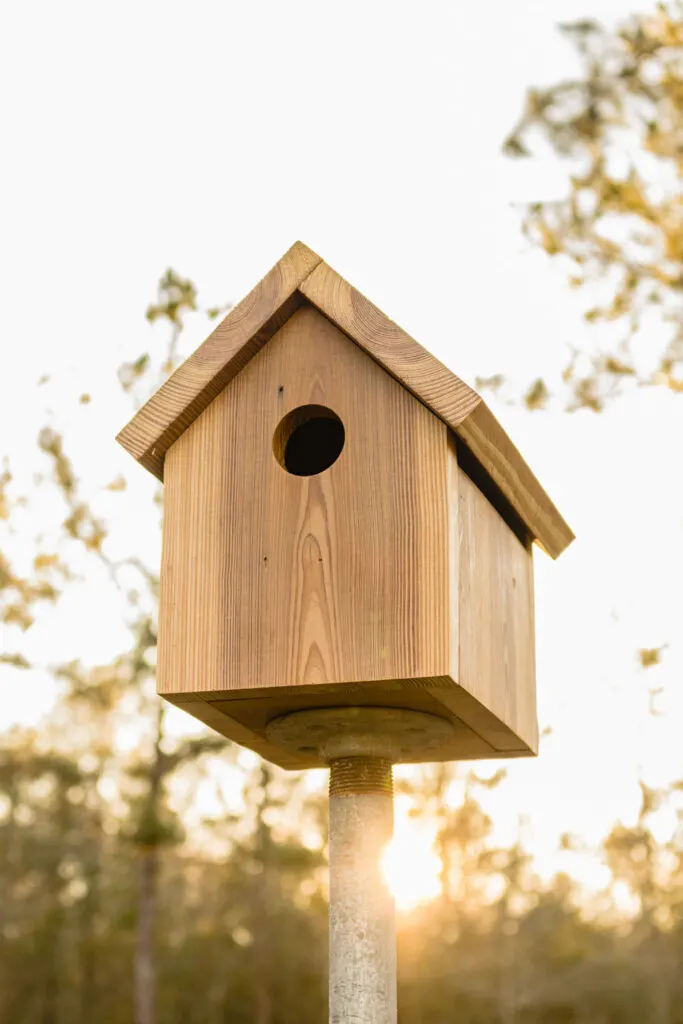
Crafting a Birdhouse with a Sturdy Square Base
Attract feathered friends to your garden with a charming and functional birdhouse. While numerous designs exist, a square base offers exceptional stability, preventing tipping and ensuring a safe haven for your avian guests. This comprehensive guide will guide you through the process of crafting a birdhouse with a square base, combining aesthetic appeal with practical considerations.
Materials and Tools
Before embarking on your construction journey, gather the necessary materials and tools:
Materials:
- Wooden boards (pine, cedar, or redwood are suitable choices)
- Wood glue
- Wood screws (1-1/4" or 1-1/2" long)
- Exterior paint or stain (optional)
- Birdhouse roof shingles (optional)
- Perch (a small branch or dowel)
- Entry hole saw (appropriate size for the bird species you wish to attract)
Tools:
- Miter saw or handsaw
- Measuring tape
- Pencil
- Drill with assorted drill bits
- Screwdriver
- Clamps (optional)
- Sandpaper (various grits)
- Safety glasses
- Dust mask
Designing the Birdhouse
The design of your birdhouse can vary according to your preferences and the bird species you wish to attract. However, a square base provides a stable foundation. Here's a basic design:
Base:
The base is the foundation of your birdhouse and should be slightly larger than the floor of the nesting cavity. A 6" x 6" base is a suitable starting point. Create four identical square pieces of wood for the base.
Sides:
The sides should be tall enough to accommodate the nesting material and birds comfortably. Aim for a height of 6" to 8". Cut four identical rectangular pieces for the sides, ensuring they are slightly wider than the base to create an overhang.
Roof:
The roof protects the nesting cavity from the elements. A simple gable roof is easy to construct. Cut two triangular pieces of wood for the roof slopes, ensuring their base aligns with the width of the birdhouse. For added durability, create a small overhang for the roof.
Entry Hole:
The entry hole should be sized appropriately for the bird species you wish to attract. A 1-1/2" to 2" diameter hole is suitable for smaller birds like chickadees and wrens. Use the entry hole saw to create the hole on one of the side panels.
Perch:
A perch allows birds to land and access the entry hole easily. A small branch or dowel will suffice. Place it directly below the entry hole and secure it with screws or glue.
Construction Process
With your design finalized, it's time to bring your birdhouse to life:
Assemble the Base:
Join the four square pieces of wood to form the base. Glue the edges together and secure them with screws for added stability. Ensure the base is level and square before proceeding.
Attach the Sides:
Attach the side panels to the base. Glue the edges together and secure them with screws. Position the panel with the entry hole at the front of the birdhouse.
Attach the Roof:
Attach the two roof slopes to the top of the birdhouse. Glue the edges together and secure them with screws. Ensure the roof slopes are flush with the sides of the birdhouse.
Install the Perch:
Attach the perch directly below the entry hole. You can either glue it in place or secure it with screws.
Finishing Touches
Once the birdhouse is assembled, it's time to add finishing touches to enhance its aesthetics and longevity:
Sanding and Finishing:
Sand the entire birdhouse with sandpaper, starting with a coarse grit to remove any rough edges and gradually progressing to finer grits for a smoother finish. This will ensure a smooth surface for painting or staining.
Painting or Staining:
Painting or staining the birdhouse is optional but adds a decorative touch. Choose exterior-grade paint or stain to protect the wood from weathering. Apply multiple coats for optimal protection and durability.
Roof Shingles:
For added protection and a traditional look, attach roof shingles to the roof. Use wood glue and small nails to secure the shingles in place.
Placement and Maintenance
Once your birdhouse is complete, choose a suitable location in your garden. The ideal placement should:
- Offer protection from strong winds and direct sunlight.
- Be positioned at least 5 feet off the ground.
- Provide easy access for you to monitor the birdhouse.
To ensure your birdhouse remains a safe and welcoming haven for birds, consider:
- Cleaning the birdhouse regularly to remove debris and old nesting material.
- Inspecting the birdhouse for damage and repairing any issues promptly.
- Avoid disturbing the birds during nesting season.
Conclusion
Crafting a birdhouse with a square base is a rewarding endeavor that provides a safe and stable shelter for feathered friends. By following this comprehensive guide, you can create a charming and functional birdhouse that will attract a variety of avian species to your garden. Remember to consider the needs of your feathered guests and maintain your birdhouse regularly to ensure it remains a welcoming sanctuary.






0 comments:
Post a Comment